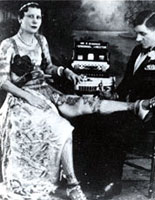LINKS










| 1800's
TATTOOING
 William Dampher is responsible for re-introducing tattooing to the west. He was a sailor and explorer who traveled the South Seas. In 1691 he brought to London a heavily tattooed Polynesian named Prince Giolo, Known as the Painted Prince. He was put on exhibition , a money making attraction, and became the rage of London. It had been 600 years since tattoos had been seen in Europe and it would be another 100 years before tattooing would make it mark in the West. William Dampher is responsible for re-introducing tattooing to the west. He was a sailor and explorer who traveled the South Seas. In 1691 he brought to London a heavily tattooed Polynesian named Prince Giolo, Known as the Painted Prince. He was put on exhibition , a money making attraction, and became the rage of London. It had been 600 years since tattoos had been seen in Europe and it would be another 100 years before tattooing would make it mark in the West.
In the late 1700s, Captain Cook made several trips to the South Pacific. The people of London welcomed his stories and were anxious to see the art and artifacts he brought back. Returning form one of this trips, he brought a heavily tattooed Polynesian named Omai. He was a sensation in London. Soon, the upper- class were getting small tattoos in discreet places. For a short time tattooing became a fad.
What kept tattooing from becoming more widespread was its slow and painstaking procedure. Each puncture of the skin was done by hand the ink was applied. In 1891, Samuel O'Rtiely patented the first electric tattooing machine. It was based on Edison's electric pen which punctured paper with a needle point. The basic design with moving coils, a tube and a needle bar, are the components of today's tattoo gun. The electric tattoo machine allowed anyone to obtain a reasonably priced, and readily available tattoo. As the average person could easily get a tattoo, the upper classes turned away from it.
By the turn of the century, tattooing had lost a great deal of credibility. Tattooists worked the sleazier sections of town. Heavily tattooed people traveled with circuses and "freak Shows." Betty Brodbent traveled with Ringling Brothers Circus in the 1930s and was a star attraction for years.
|